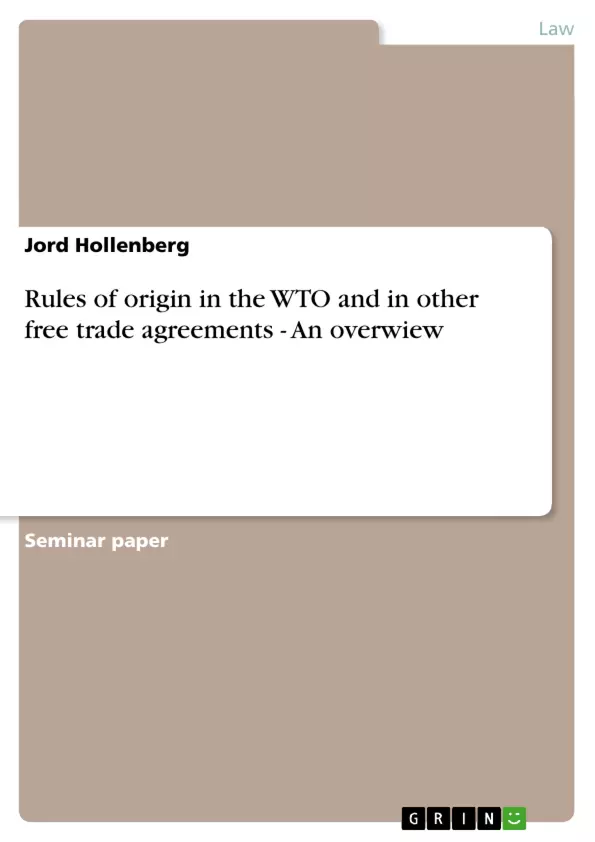One of the main objectives of rules of origin should be uniformity and simplicity in their administration. Although this is not always true, developing and developed countries have undertaken the task towards simplification, harmonization and liberalization of rules of origin. This harmonization work has been carried out under the auspices of the Committee on Rules of Origin (CRO) of the World Trade Organization (WTO) and the Technical Committee on Rules of Origin (TCRO) of the Brussels-based World Customs Cooperation Council, which has been responsible for the technical part of the work, including discussions on the rules of origin options for each product.
After all, an Agreement on Rules of Origin (ARO) was established in the WTO. This ‘first-ever’ agreement is designed to harmonize and to clarify non-preferential rules of origin for goods in trade on the basis of the substantial transformation test. The WTO wants to ensure that their rules are transparent and do not distort or disrupt on international trade, that they are administered in a consistent, uniform, impartial and reasonable manner, and that they are based on a positive standard. That means the ARO in WTO wants to state what does confer origin rather than what does not.
This work wants to give an overview about
- 'Non-preferential Rules of Origin', especially the dispute concerning the New American Rules of Origin for Textile Products among the European Communities and the United States (WT/DS85;WT/DS151)
- 'Preferential Rules of Origin'
- 'Rules of Origin as a Trade Barrier'
- 'Rules of Origin as a Factor of Production'
Inhaltsverzeichnis (Table of Contents)
- Rules of Origin
- Introduction "The Core Issue of Rules of Origin"
- Historical Background and Development
- Methods of Determining Origin
- Substantial Transformation
- Ad Valorem Percentage Test
- Specified Process Test
- Change in Tariff Heading Test (CTH)
- Defining Rules of Origin under GATT/WTO
- Non-preferential Rules of Origin
- Dispute concerning the New American Rules of Origin for Textile Products among the European Communities and the United States (WT/DS85; WT/DS151)
- The Core of the EC-US conflict
- Measures Affecting Textiles and Apparel Products (I); WT/DS85
- Measures Affecting Textiles and Apparel Products (II); WT/DS151
- Result
- Preferential Rules of Origin
- Rules of Origin as a Trade Barrier
- Rules of Origin as a Factor of Production
- Conclusion
Zielsetzung und Themenschwerpunkte (Objectives and Key Themes)
This document aims to provide an overview of rules of origin, their historical development, and their role in international trade. It explores the various methods used to determine the origin of goods and how these rules are applied in both non-preferential and preferential trade agreements.
- The evolution and significance of rules of origin in international trade
- Different methods for determining the origin of products, such as substantial transformation and ad valorem percentage tests
- The role of rules of origin in trade agreements, including the World Trade Organization (WTO) and free trade agreements
- The potential for rules of origin to act as trade barriers
- The impact of rules of origin on production processes and global supply chains
Zusammenfassung der Kapitel (Chapter Summaries)
The introduction explains the fundamental importance of rules of origin in determining the nationality of imported goods and their impact on trade restrictions and preferences. It highlights the complexities of origin determination in the context of globalized production chains.
The historical background delves into the evolution of rules of origin, noting their absence in the initial GATT agreement and the subsequent push for harmonization and simplification driven by the increasing number of trade agreements and disputes.
The chapter on methods of determining origin covers the two primary criteria: wholly obtained or produced, and substantial transformation. It also delves into specific tests such as the ad valorem percentage test and the change in tariff heading test, explaining their application in origin determination.
The section on defining rules of origin under GATT/WTO discusses both non-preferential and preferential rules, examining the dispute between the European Communities and the United States regarding textile products as an example of the challenges posed by non-preferential rules. It also touches upon the role of preferential rules in facilitating trade within free trade areas.
Schlüsselwörter (Keywords)
Rules of origin, international trade, free trade agreements, WTO, GATT, substantial transformation, ad valorem percentage test, non-preferential rules, preferential rules, trade barriers, global supply chains, origin determination, harmonization, simplification, dispute resolution.
- Quote paper
- Ass. Iur., LL.M. Jord Hollenberg (Author), 2003, Rules of origin in the WTO and in other free trade agreements - An overwiew, Munich, GRIN Verlag, https://www.grin.com/document/41007



